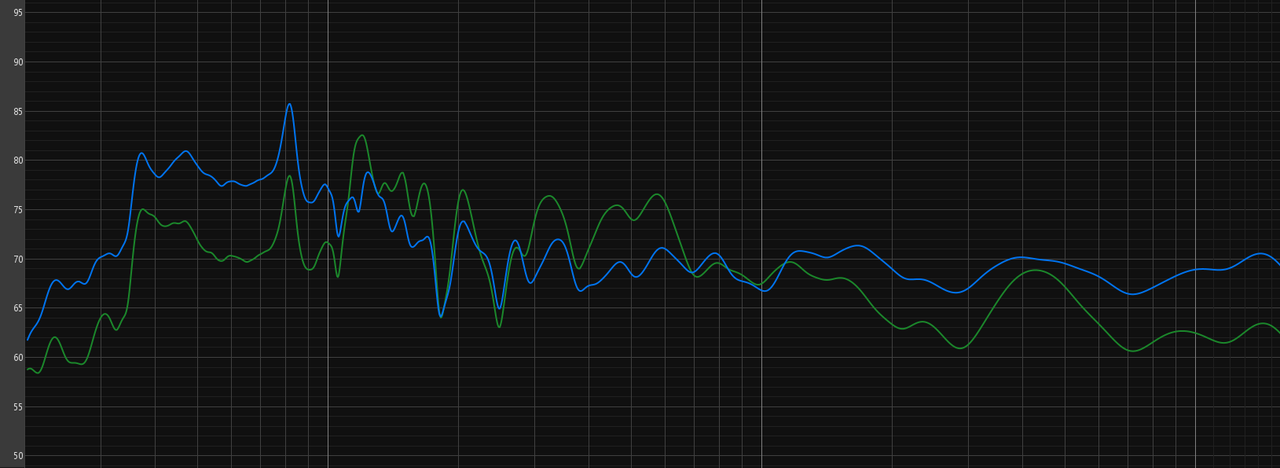I've tried out room correction for my PC audio and thought I'd share some of my findings.
Preamble - My setup:
Raw Results - Dirac Live:

Raw Results - REW + Equalizer APO:

Findings:

Preamble - My setup:
- Naturally, it's a nearfield listening position. Speakers are on my desk and are ~10cm from the rear wall. This is far from an ideal listening environment! My aim with this exercise was simply to size up Dirac, with all else being equal.
- Bookshelves - Edifier S2000 Pro. I've disconnected my sub so it's just 2.0.
- Windows PC as the source
Raw Results - Dirac Live:
- I ran measurements in Dirac Room Correction Suite (on Windows) with a UMIK-1 pointed at the ceiling, which is shown in the image below.
- NB: I thought that I would have to point the mic at my monitor since this was a nearfield measurement, but Dirac software suggests pointing it upwards.
- Mustard curve is the default target curve ("house curve") in Dirac, which is editable. Dim pink curve is before room correction. Bright pink is its predicted response after correction. I find that predicted responses are far from truth, so I've included the measured response after correction at the end of this post.

Raw Results - REW + Equalizer APO:
- Here I used REW to measure the combined raw response of my speakers with UMIK-1. I then generated an EQ correction file from that measurement with my own custom target curve. Finally, I imported that EQ file into Equalizer APO to correct the frequency response of my speakers.
- Green curve is the raw (L+R) response. Blue is the measured response after correction with REW+Equalizer APO. Both measurements taken at 70 dB. VAR smoothing.

Findings:
- First off, the difference between EQ and no-EQ is night and day in this setup. Without EQ, my speakers sounded bloated. The response curve above shows the elevation in upper bass and midrange, along with a shelved top-end.
- Not wanting to rile up members, but trying to correct these issues purely by "system matching" (buying and selling lots of equipment) would be a ridiculous exercise considering the graphs above. EQ is a powerful tool and can be used to great effect. I do enjoy playing around with different equipment, but I have to be honest with myself on the reasons - it's fun to tinker and try new things.
- Now to the main event, Dirac vs. REW+E-APO (just "REW" below).
- It's far easier to get going with Dirac. Although REW is straight-forward to learn (you'll be up and running within a hour), Dirac is point and click. It's hard to compete with that level of convenience.
- Dirac sounded noticeably better than REW out of the box. Notably, this was after I spent quite some time measuring and tweaking with REW to improve my results. I suspect this is due to Dirac measuring and correcting my speakers individually, as well as correcting in both the time and frequency domains. Imaging was notably better with Dirac than REW. You'll find the corrected measurements below - REW in blue and Dirac in pink. Both taken at 70dB.
- Where the REW solution wins hands down is in how seamlessly it works after calibration. You won't even notice it running in the background. It just does its thing without fuss. On the other hand, Dirac software is incredibly clunky on Windows. You have to manually start and keep the software open so that its virtual output device is available. I use Windows' volume to control my speakers (they're active) and I have to crank up their volume in Windows to get a decent output with Dirac. However, if the Dirac software closes for whatever reason (or you didn't start it), the sound level jumps right back to that cranked up level. Wildly inconvenient.
- Ultimately, I'm going to continue with REW in this setup due to the convenience. It was great to try out Dirac to see what is possible. It's free for 14 days so I encourage anyone using PC as a source to give it a shot too. Please report your findings on the forum if you do. That said, I will definitely be looking for Dirac (with DLBC) in my next AVR (currently have Audyssey XT32). Side note: the prices of AVRs have gone up more than Nvidia shares. Sad times.

Last edited:
